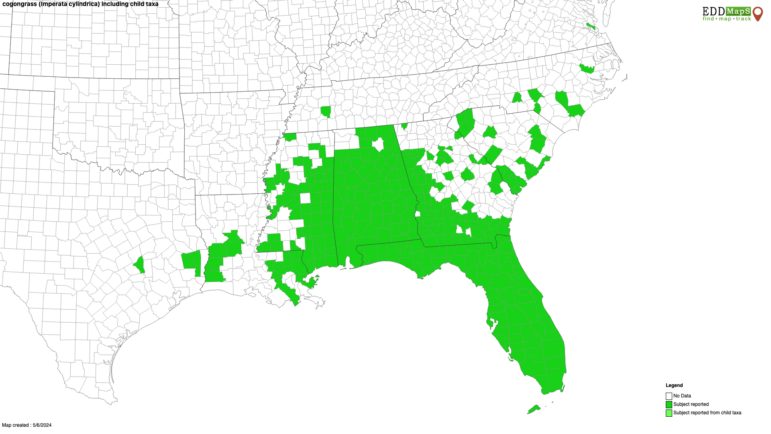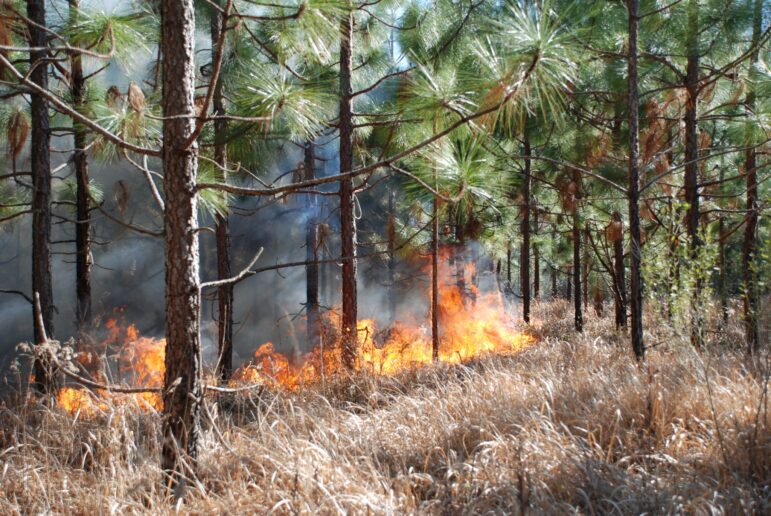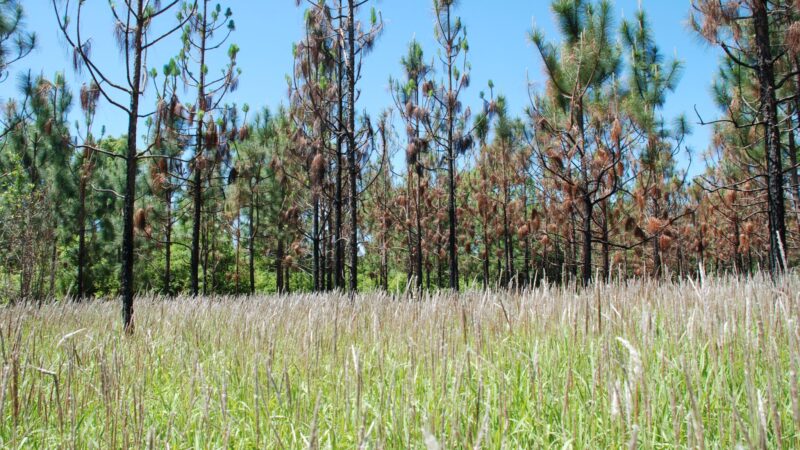This spiky-stemmed invasive grass is taking over Alabama
On his family’s land in rural Etowah County, Nick Jackson grows loblolly pine trees among a diverse range of vegetation, from oak trees to blueberry bushes.
But in 2016, a new species popped up on the property.
“We were doing site prep for planting loblolly pine, and we noticed a circular pattern of grass that was different in color to the surrounding area,” Jackson said. “That’s what triggered us to investigate a little bit further. And it was cogongrass.”
Cogongrass is an invasive plant that easily spreads and aggressively crowds out native species. And despite statewide mitigation efforts, it’s taking over Alabama.
Not your typical grass
At first glance, there’s nothing especially unique about cogongrass. Its thin green leaves stretch several feet high and produce fluffy, white dandelion-like seeds in the summer. The grass grows in thick, circular patches with intricate underground webs of spiky stems known as rhizomes.
“It’s so thick, it chokes out all the natural plants and grasses that the ecosystem is dependent on. So this has a large impact on the diversity and health of the ecosystem,” Jackson said.
Where cogongrass grows, few species survive. No crops. No timber. And the grass is really hard to get rid of.
“It’s one of the top ten worst weeds in the world, and it’s a weed everywhere,” said Nancy Loewenstein, an extension specialist with Auburn University.
Loewenstein has studied cogongrass for nearly two decades. She said the species entered the US in the early 1900s through the port of Mobile and spread under the radar for decades.
“For the longest time it can appear that you don’t really have a problem,” Loewenstein said. “And then the population gets to such a point where it starts spreading really rapidly. And all the sudden it’s like, ‘Good grief. This stuff is everywhere. How’d that happen?’”
Alabama is at that point.
What doesn’t kill it, makes it stronger
Today, cogongrass is found in 62 of Alabama’s 67 counties and has especially saturated the southern part of the state.

Part of what makes cogongrass such a well-adapted species is that it evades many mitigation strategies.
Animals don’t eat the grass, because it’s difficult to digest. Landowners can’t mow it away, because that could stir up the underground rhizomes, which can break off and sprout new cogongrass infestations.
Burning the plant is also off the table.
“It’s a fire-adapted species, so fire actually contributes to its spread and its vigor,” Loewenstein said.
The most effective way to get rid of cogongrass is treating it with herbicides, which can be a controversial approach, according to Emma McKee, invasive species coordinator with the Longleaf Alliance.
McKee works with landowners in southern Alabama who face cogongrass infestations and said sometimes they are against spraying chemicals on their property.
“But by the end of my 10-minute spiel about how intense this plant is, they’re on board with using the herbicide,” McKee said.

Drawing a line in the sand
When applied carefully and correctly, landowners like Jackson said the treatment is worth it.
In 2022, Jackson signed up with a new program offered by the Alabama Forestry Commission (AFC). For three years, the agency sends people to his property to spray the cogongrass infestation once a year at no charge.
“They’ve done a great job,” Jackson said. “They (the AFC) can control how they spray very precisely. They limit any overspray or undesirable mortality of the native vegetation.”
Jackson said the herbicides have helped kill some of the cogongrass patch, and have stopped the species from expanding further on his property.
That’s likely the best outcome, according to Loewenstein. She said across much of south Alabama, cogongrass has spread so much, it’s unlikely landowners will be able to get rid of it. But there is still time to protect land in the northern part of the state.
“We know how to not spread it,” Loewenstein said. “So if we can make a line in the sand … let’s keep it from spreading further.”
Viral global TikToks: A twist on soccer, Tanzania’s Charlie Chaplin, hope in Gaza
TikToks are everywhere (well, except countries like Australia and India, where they've been banned.) We talk to the creators of some of the year's most popular reels from the Global South.
This painting is missing. Do you have it?
An important work from a rediscovered artist has been absent from public view since the 1970s. A New York curator is hunting for it.
Memory loss: As AI gobbles up chips, prices for devices may rise
Demand for memory chips currently exceeds supply and there's very little chance of that changing any time soon. More chips for AI means less available for other products such as computers and phones and that could drive up those prices too.
Brigitte Bardot, sex goddess of cinema, has died
Legendary screen siren and animal rights activist Brigitte Bardot has died at age 91. The alluring former model starred in numerous movies, often playing the highly sexualized love interest.
For Ukrainians, a nuclear missile museum is a bitter reminder of what the country gave up
The Museum of Strategic Missile Forces tells the story of how Ukraine dismantled its nuclear weapons arsenal after independence in 1991. Today many Ukrainians believe that decision to give up nukes was a mistake.
Jeffrey R. Holland, next in line to lead Church of Jesus Christ of Latter-day Saints, dies at 85
Jeffrey R. Holland led the Quorum of the Twelve Apostles, a key governing body. He was next in line to become the church's president.









